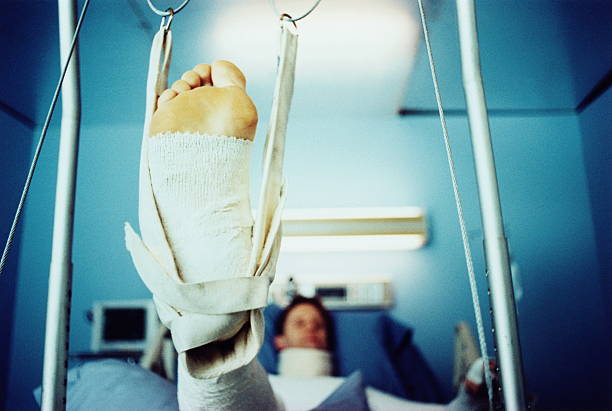If you have suffered a broken leg due to medical negligence, you may be entitled to compensation. Medical negligence occurs when a healthcare professional fails to provide the appropriate standard of care, resulting in harm to the patient. Broken legs are a common injury that can occur due to medical negligence during surgery, treatment, or misdiagnosis.
Surgery errors, such as incorrect placement of screws or plates, can result in a broken leg. Misdiagnosis or failure to diagnose a broken leg can also lead to further complications and injuries. If you have experienced a misdiagnosis or failure to diagnose a broken leg, you may have grounds for a medical negligence claim. Additionally, failure to refer an accident victim with a broken leg to a specialist, such as an orthopedic surgeon, may also be grounds for medical negligence or medical malpractice claims.
If you have suffered a broken leg due to medical negligence, then seek legal advice as soon as possible. A qualified medical negligence lawyer can help you understand your rights and options for pursuing compensation. In the following paragraphs, we will explore the legal definition of medical negligence, common types of medical negligence claims, and the compensation payouts for broken leg injuries.
Medical Negligence in Broken Leg Cases
Definition of Medical Negligence
Medical negligence occurs when a healthcare provider fails to provide the accepted medical standard of care, resulting in injury or harm to the patient. In the case of a broken leg, medical negligence can occur if a doctor fails to diagnose the fracture, misdiagnoses the fracture, or fails to provide appropriate treatment for the fracture.
Types of Medical Negligence
Medical negligence can take many forms in broken leg cases. Some common types of medical negligence include misdiagnosis, delayed diagnosis, failure to diagnose, failure to provide appropriate treatment, surgical errors, infections, and failure to recognize complications.
Duty of Care in Medical Negligence Cases
Doctors and healthcare providers have a duty of care to their patients. This means that they are obligated to provide a certain level of care to their patients, and failure to do so can result in medical negligence. In the case of a broken leg, a doctor has a duty of care to diagnose the fracture, provide appropriate treatment, and monitor the healing process.
If you believe that you have been the victim of medical negligence in a broken leg case, you may have a legal right to compensation. A medical malpractice attorney can help you understand your legal rights and options.
It is important to note that not all medical errors or complications are considered medical negligence. To prove medical negligence, it must be shown that the healthcare provider failed to meet the accepted medical standard of care, and that this failure resulted in injury or harm to the patient.
Prevention is key in avoiding medical negligence in broken leg cases. Patients should seek medical attention as soon as possible if they suspect a fracture, and doctors should provide appropriate diagnosis and treatment to prevent further injury or complications.
In summary, medical negligence in broken leg cases can have serious consequences, including severe pain, swelling, and even wrongful death. If you believe that you have been the victim of medical negligence, it is important to seek legal advice and understand your options for compensation.
Diagnosing a Broken Leg
If you suspect that you have a broken leg, it is important to seek medical attention immediately. A delay in diagnosis and treatment can lead to complications and a longer recovery time. Here are some of the key things to know about diagnosing a broken leg.
Symptoms of a Broken Leg
The symptoms of a broken leg can vary depending on the location and severity of the injury. Some common symptoms include:
- Pain, swelling, and tenderness in the affected area
- Difficulty or inability to bear weight on the leg
- Bruising or discoloration
- Deformity or visible bone fragments
- Numbness or tingling in the leg or foot
If you experience any of these symptoms after an injury or accident, it is important to see a doctor as soon as possible.
Diagnostic Tests for a Broken Leg
To diagnose a broken leg, your doctor will likely perform a physical examination and order imaging tests such as X-rays. X-rays can help your doctor determine the location and severity of the fracture.
In some cases, your doctor may also order a CT scan or MRI to get a more detailed view of the injury. These tests can help identify any associated soft tissue damage or other complications.
Misdiagnosis and Failure to Diagnose
Misdiagnosis or failure to diagnose a broken leg can have serious consequences. If a fracture is not properly diagnosed and treated, it can lead to long-term complications such as chronic pain, arthritis, or difficulty walking.
In some cases, a misdiagnosis or failure to diagnose may be the result of medical negligence. If you believe that your doctor failed to diagnose your broken leg, you may be able to pursue a medical malpractice claim.
In conclusion, if you suspect that you have a broken leg, it is important to seek medical attention right away. Your doctor can perform a physical examination and order diagnostic tests to determine the location and severity of the fracture. If you believe that your doctor failed to diagnose your injury, it is important to speak with an experienced medical malpractice attorney.
Treatment Options for a Broken Leg
If you have a broken leg, your treatment options will depend on the severity of the break. In most cases, treatment for a broken leg involves immobilizing the leg to allow it to heal properly. Here are some of the treatment options for a broken leg:
Non-Surgical Treatment for a Broken Leg
If you have a simple or stable fracture, your doctor may recommend non-surgical treatment for your broken leg. This may involve wearing a cast or a splint to immobilize the leg and allow the bone to heal. You may also need to use crutches or a wheelchair to keep weight off the leg while it heals. Non-surgical treatment is usually successful in healing most broken legs.
Surgical Treatment for a Broken Leg
If you have a more severe or complicated fracture, your doctor may recommend surgical treatment for your broken leg. This may involve using plates, screws, or rods to hold the broken bone in place while it heals. Surgery may also be necessary if the broken bone has pierced the skin or if the bone is not healing properly.
Complications of Broken Leg Treatment
While treatment for a broken leg is usually successful, there are some complications that can occur. These may include:
- Infection at the site of the break
- Delayed healing or non-union of the bone
- Mal-union of the bone, where the bone heals in the wrong position
- Nerve or blood vessel damage
If you experience any of these complications, it is important to talk to your doctor right away to prevent further damage or complications.
In conclusion, treatment for a broken leg can involve non-surgical or surgical options depending on the severity of the break. Non-surgical treatment may involve wearing a cast or a splint, while surgical treatment may involve using plates, screws, or rods to hold the broken bone in place. Complications of broken leg treatment may include infection, delayed healing, mal-union, or nerve or blood vessel damage. If you experience any complications, it is important to talk to your doctor right away to prevent further damage or complications.
Medical Negligence in Broken Leg Cases
If you have suffered a broken leg due to medical negligence, you may be entitled to compensation for your injuries. Medical negligence is a serious issue that can have devastating consequences for patients. In the case of broken legs, medical negligence can occur in both the diagnosis and treatment of the injury.
Medical Negligence in Diagnosis
Medical negligence in the diagnosis of a broken leg can occur if a doctor fails to properly identify the injury. This can happen if the doctor does not order the appropriate tests, misinterprets the results of tests, or fails to recognize the symptoms of a broken leg. If a broken leg is not diagnosed in a timely manner, it can lead to serious complications and long-term damage.
Medical Negligence in Treatment
Medical negligence in the treatment of a broken leg can occur if a doctor fails to provide the appropriate care for the injury. This can happen if the doctor fails to properly set the bone, prescribes the wrong medication, or performs surgery incorrectly. If the appropriate treatment is not provided, the broken leg may not heal properly, leading to long-term complications and disability.
Proving Medical Negligence in Broken Leg Cases
Proving medical negligence in broken leg cases can be challenging, as it requires showing that the doctor deviated from the accepted medical standard of care. To prove medical negligence, you must show that:
- The doctor had a duty to provide you with the appropriate care
- The doctor breached that duty by failing to provide the appropriate care
- The breach of duty caused your injuries
- You suffered damages as a result of the breach of duty
If you believe that you have suffered a broken leg due to medical negligence, it is important to speak with a medical malpractice attorney. An experienced attorney can help you understand your legal right to compensation and can assist you in proving your case in court. In some cases, a jury award may be necessary to obtain the compensation you deserve.
Preventing Broken Legs
Broken legs can be a painful and debilitating injury that can affect people of all ages. While accidents do happen, there are steps you can take to prevent broken legs from occurring. In this section, we will discuss some tips on how to prevent broken legs in children, adults, and the elderly.
Preventing Broken Legs in Children
Children are particularly prone to broken legs due to their active lifestyles and developing bones. Here are some tips to help prevent broken legs in children:
- Encourage safe play: Teach your children to play safely and avoid roughhousing or playing on unsafe surfaces.
- Provide protective gear: Provide your children with appropriate protective gear, such as helmets, knee pads, and shin guards for sports activities.
- Supervise play: Supervise your children’s playtime to ensure they are playing safely and not engaging in risky behavior.
Preventing Broken Legs in Adults
Adults can also suffer from broken legs due to accidents or underlying health conditions. Here are some tips to help prevent broken legs in adults:
- Maintain a healthy lifestyle: Eating a healthy diet and staying physically active can help prevent conditions like osteoporosis, which can increase the risk of broken bones.
- Manage underlying health conditions: If you have a health condition like diabetes that can affect bone health, work with your doctor to manage the condition and reduce your risk of broken bones.
- Be mindful of falls: Falls are a common cause of broken legs in adults. Be mindful of your surroundings and take precautions to prevent falls, such as wearing appropriate footwear and using handrails when going up and down stairs.
Preventing Broken Legs in the Elderly
The elderly are at an increased risk of broken legs due to age-related changes in bone density and balance. Here are some tips to help prevent broken legs in the elderly:
- Use restraints: If you or a loved one is at risk of falling, use restraints like bed rails or chair alarms to prevent falls.
- Remove tripping hazards: Remove tripping hazards like loose rugs or clutter from living spaces to reduce the risk of falls.
- Stay active: Regular exercise can help improve balance and reduce the risk of falls.
By following these tips, you can help prevent broken legs and other injuries from occurring. However, if you or a loved one does suffer from a broken leg due to clinical negligence, it is important to seek legal advice to understand your options for pursuing compensation.
Frequently Asked Questions
What compensation can I receive for a missed fracture?
If you have suffered a missed fracture due to medical negligence, you may be entitled to compensation for your pain and suffering, loss of earnings, and medical expenses. The amount of compensation you can receive will depend on the severity of your injury and the impact it has had on your life.
What is the typical settlement for a broken leg case?
There is no typical settlement for a broken leg case, as each case is unique. The amount of compensation you can receive will depend on factors such as the severity of your injury, the impact it has had on your life, and the degree of negligence involved.
What constitutes a serious injury in a medical negligence case?
A serious injury in a medical negligence case is one that has had a significant impact on your life. This can include injuries such as a missed fracture, which can result in prolonged pain, suffering, and disability.
Can I sue for misdiagnosis of a fracture?
Yes, you can sue for misdiagnosis of a fracture if it was due to medical negligence. If a healthcare professional failed to diagnose your fracture, resulting in prolonged pain, suffering, and disability, you may be entitled to compensation.
What is considered medical negligence in a missed fracture case?
Medical negligence in a missed fracture case occurs when a healthcare professional fails to diagnose a fracture, resulting in prolonged pain, suffering, and disability. This can be due to a failure to order an x-ray, misinterpretation of test results, or failure to refer you to a specialist.
What evidence do I need to prove medical negligence in a broken leg case?
To prove medical negligence in a broken leg case, you will need to provide evidence that the healthcare professional failed to provide an appropriate standard of care. This can include medical records, witness statements, and expert testimony.
Conclusion
Medical negligence is a serious issue that can have long-lasting consequences, both physically and emotionally.
Remember that medical negligence occurs when a healthcare professional fails to provide an adequate standard of care, resulting in harm to the patient. This may include misdiagnosis, delayed diagnosis, incorrect treatment, or surgical errors.
If you believe that you have suffered harm as a result of medical negligence, it is important to keep detailed records of your medical treatment, including any conversations with healthcare professionals. This will help to support your case should you decide to pursue legal action.
It is also important to remember that medical negligence cases can be complex and time-consuming. It is therefore advisable to seek the assistance of an experienced medical negligence lawyer who can guide you through the process and help you to achieve the best possible outcome.
In summary, if you have suffered a broken leg due to medical negligence, it is important to take action to protect your rights and ensure that you receive the compensation you deserve. By seeking legal advice and working with an experienced lawyer, you can hold healthcare professionals accountable for their actions and take steps to prevent similar incidents from occurring in the future.












